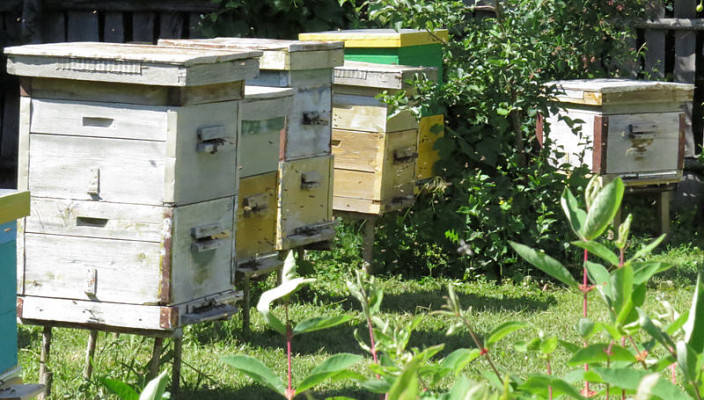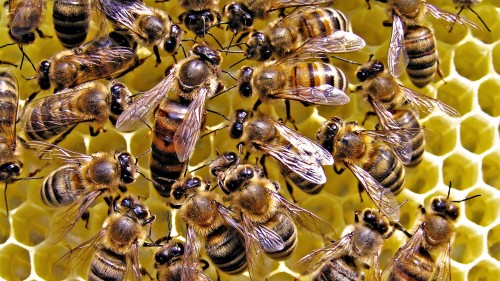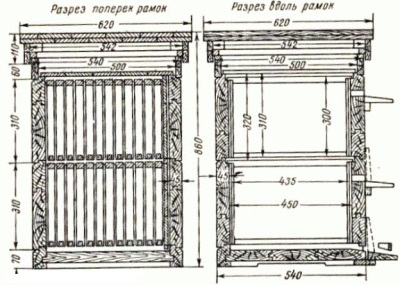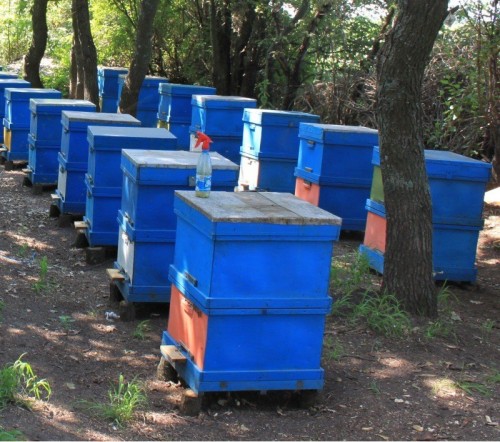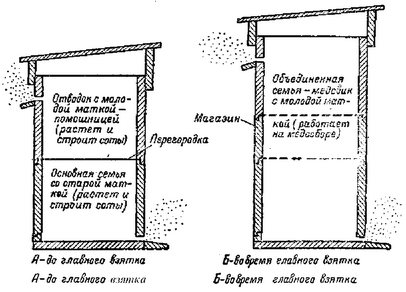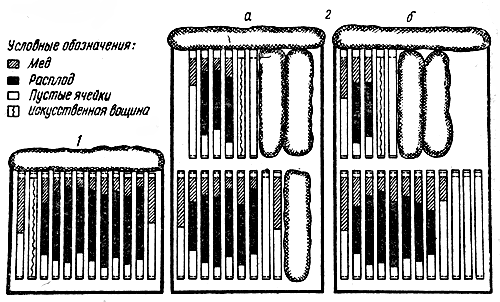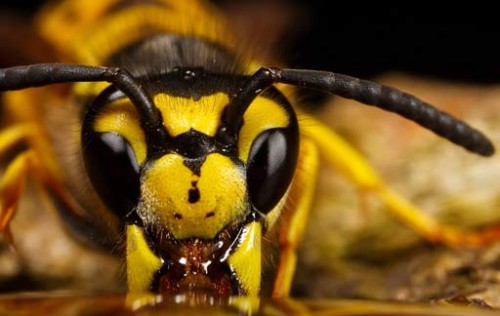According to many beekeepers, the content of bees in two-circuit hives is more productive than in Dadanovsky and 12-frame structures. This method of breeding bees allows you to increase their number. In addition, the amount of honey produced is increasing, the emergence of the bee is prevented. The quality of the collected honey is improved. In such "houses", the work of the bee is directed exclusively to collecting honey. Therefore, this technique is very popular at beekeepers. It is mainly common in the Urals, the Far East. Further, the article will be told about the content of bees in two-circuit hives.
Content
Content bees: Highlights
Let us dwell on the disadvantages of the content of bees in the 12-frame and Dadanovskaya hives:
- Due to the fact that such structures have a small volume, the intensity of the bee is significantly reduced.
- The likelihood of the emergence of the ROOH state increases.
- In such designs, it is difficult to select compartment for storing blanks for bees for the winter.
- Often honey collected by bees accumulates within the framework, as a result of which it is crystallized and becomes unsuitable for use.
All the above disadvantages do not have two-circuit hives. They are structures consisting of several frames placed in 2 housings. In this case, the bees family is located in 8-10 of all available frames, so there are all the possibilities for the effective collection of honey. The sizes of each cell in such an ule are 430 by 300 mm. It is important to install the second building on the hive on the hive to prevent the occurrence of rosy. After all, this instinct at bees is provoked precisely in flavored.
The second case is set immediately as soon as the beeshoe family grows and placed on 7-8 frames with a breakdown. If you dispose and put the top compartment too late, the bees begin to swallow, the young breakdown remains "without work" and does not collect honey. The housing in the hive is set to about 30-40 days before the occurrence of the cells.
How is the installation of a new case? Consider a Read more:
- Initially, a frame with bee eggs and a breakdown is placed in it.
- Next, sections with the participation are made inside.
- From both sides there are honeycombs for collecting honey.
- Frames are transferred to a new compartment together with bees that are on them.
- Next, all the frames need to be insulated and limited to the plug-in board.
- In order for the bees to be spacious, in the lower compartment, it is similar to the framework at a certain distance. Then they are inspired by the same principle as in the upper case.
- Each case must be placed 2 cells with a carrier.
- Open breakdown should be placed in the lower tier, and in the upper - sealed (printed).
- Next, the second body is placed on top of the first, and is insulated. For insulation, a pillow is a flat shape or blanket.
Today you can buy a two-circuit hives to buy in specialized stores or make them personally.
The design of such a hive is represented schematically in the picture:
It is worth saying that the two-tier structures are not suitable in all cases. For example, they will be very good for strong families with greater performance. As for weak families, they will not be able to mascel all the two tiers, and their ability to the medical care will become even more sluggish. In addition, working with bunk hives is very painstaking and time-consuming, it should be accurately and in a timely manner to comply with all the rules and recommendations. Therefore, it will be too complicated for older and inexperienced beekeepers. Even physically strong people to work with bunk structures are often resorted to the help of other beekeepers.
Breeding bees in two-circuit hives
Rules for the content of bee
Over time, the bee family will develop, and increase their number. As it is height, add new compartments. In addition, in a timely manner should be placed in the housing of the cell. Initially added brown, and then light yellow honeycombs.
If a good and dry weather is held for a long time, then the expansion of the bee family can be carried out only by adding new sections with the participation. They are installed near the last breakfast cell. The expansion of the lower and upper tier should be carried out simultaneously. In order to increase the productivity of the family and the speech-availability of the apiary, you can occasionally clean up already rebuilt honeycombs.
With good weather there is another way to expand the nest. So, in this case, not sections with a carrier should be added to the upper tier, but a frame with an open breakdown, brown cells and honey cells. All sections are neatly folded in the compartment. Each of them should be limited to inserted horses. Next, the upper tier is installed on the bottom and is heated. In this case, the expansion of the family passes only in the upper tier.
Before the start of the main honeycomb cell in the hive should be regrouped. Open breakdown, as mentioned above, should be placed in the lower tier, and in the upper - sealed (printed). In addition, rebounded cells and cells with a carrier are added to the lower tier. As you know, bees collected honey are placed in the upper cells. Therefore, if you do not regroup the cells in a timely manner, then the upper compartment will be all covered with honey, and in the lower - the perga is accumulated.
It is worth saying that the addition of cells should not be carried out during a medical device, if every day the bee is collected 2.3 kg of nectar. With a strong honey collection (more than 3 kg per day), add additional sections with the manufacturer. After graduating from the collection of honey, the second tier should be removed. Usually at this point the number of bee families is reduced.
Simplified method
This method is characterized in that the second tier is placed not three, but only 1-2 frames with a breakdown. At the same time, the bees moved from the frame must be of different ages. From both sides of the compartment, honey cells are installed. In the lower tier are placed rebuilt cells or cells with a cooker. All frames should be divided by special arms. Next, the hive is insulating. To expand the second case, with an increase in the bee family, you can add a hollow frame.
Most often, the uterus turns into the upper tier in order to postpone the eggs in the section of the rebounded cells. Together with the uterus, other bees are moved, as a result of which the compartment begin to finish with new cells. In this case, the productivity of the family increases and does not occur.
Matter tanks
If the plants from which the bee nectar are most often blooming too late, then in this case there may be a decrease in the productivity of the family and the appearance of the level of rosium. It does not help even two-circular disbanding bees. The output from this situation will be the selection of several cells with a sealed breastplate. Thus, you can avoid overpopulation of the nest.
From those cells that were withdrawn from the hive, you can equip a new young bees. They will be able to strengthen the main bee family during the train. A new chain is formed only if all 12 cells existing in the ulle are already filled with bees. So, the frames should be transferred to the new compartment. Watch that along with part of the bees in the cell turned out to be an old bee uterus.
After you have equipped a new chain, the compartment is placed on the main hive. However, note that the new building should be sent by the pilot to the other side so that the bees are not mixed as a result. It is best to form a young gag in the morning. After the bees are accustomed to a new tray, a mature motherbook is added to the young family. In order for bees to get used to a new uterus, it must be kept at first under the cap.
Every week you can take 2-3 frames with a breakdown from the main bee of the family and enhance with them a new chain. In addition, the new compartment should be complemented by cells with a cooker. Especially in the case when the uterus put the eggs. Thus, no overpopulation of the bee family occurs, since it is systematically sitting in a new compartment. Moreover, unwanted bees is not formed, and the number of honey cells is increasing.
With the main family of young chain, it should be combined before the start of the collection of honey. Thus, you will get a strong and healthy family of bees, ready to work fruitfully for honey production. The association must be carried out according to the following scheme:
- Initially, you should find the old uterus and les it into a new compartment. This compartment is usually applied in the case when you need to increase the bee family to the winter period or to the Late Medosphere.
- Next, they are rearranged by the frames in the hive. Rearrangement passes along the same technique that has been described above. All honeycombs with an open breakdown are placed in the lower tier, and in the upper compartment - with sealed. It should be done on time to prevent the accumulation of perme in the lower yarus.
- Then, all the housings are put on honey. Usually it is acquired in the finished form in specialized stores.
After the new chain is combined with the main bee family, it becomes closely in the hive, although it has several buildings. And since during the training period, many compartments are busy with a breakdown from two modules, produced by honey lacks space. In this case, it is recommended from above to the main socket to place the extension. Similar structures can be similar in specialized stores. Usually their dimensions are 435 by 145 mm. They are intended to collect produced honey by combined families. Depending on the number of collected honey, the number of data data is also adjustable. For example, for strong bee families, you can set 10-12 stands.

